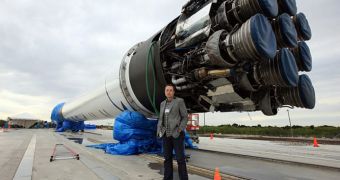Representatives at the private company Space Exploration Technologies (SpaceX) announce that their delivery vehicle, the Falcon 9, has finally been integrated at the Cape Canaveral Air Force Station, in Florida. Located just a few miles away from the Kennedy Space Center (KSC), the facility will be the primary launch site of the new rockets, which are planned as part of the fleet of spacecraft that will replace the aging space shuttles, when they are retired this September. The maiden flight of the new rocket will most likely take place in the coming months, SpaceX officials say.
Under the contract the company signed with the American space agency NASA, it needs to conduct its first demo flight in the first half of 2010, with another one scheduled for another launch date between May and November. By next year, the Falcon 9 should theoretically be able to deliver supplies to the International Space Station (ISS). The cargo will be placed in the Dragon space capsule, which will then become a part of the international fleet serving the outpost. The fleet also includes the Russian Progress and Soyuz capsules, the European Automated Transfer Vehicle (ATV), and the Japanese H-II Transfer Vehicle (HTV).
By 2014, SpaceX plans to convert the design of their Dragon spacecraft to also accommodate astronauts. This may become possible under the new NASA budget, which has been awarded about $6 billion for supporting innovation in the private sector. “Elon [Musk, co-founder of PayPal] started this company with the hopes of making space more accessible for professional crews – not necessarily joy-riders or tourists – and really to facilitate the manned exploration of space,” says the President of SpaceX, Gwynne Shotwell, quoted by Space. Under the $1.6 billion contract it has with NASA, the company needs to fly 12 resupply missions to the ISS.
“One of the most exciting things, to me, about the 2011 NASA budget is that it acknowledges one of the biggest barriers to exploring space, and that barrier is how do you pay for it,” said of the new direction for the space agency former NASA astronaut Ken Bowersox. He is currently the Vice President for astronaut safety at SpaceX. “History shows that the first two flights of any vehicle is a struggle. We're certainly not rushing to the flight line,” Shotwell mentions, adding that the company will launch Falcon 9 only after all systems are deemed flight-worthy.

 14 DAY TRIAL //
14 DAY TRIAL //